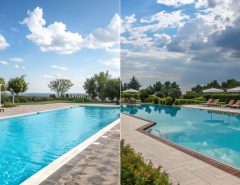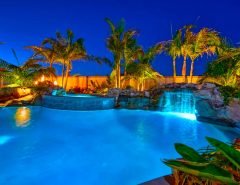A good pool cleaner does more than skim leaves, it helps keep your water balanced, equipment safe, and surfaces looking new. Understanding how spring and fall affect your pool makes routine care easier and prevents costly surprises later.
Why Seasonal Pool Maintenance Matters
Your pool isn’t static, it reacts to temperature, sunlight, rainfall, and how much you’re using it. Thoughtful seasonal pool maintenance keeps water clear, prevents damage, and saves money over time.
Water chemistry shifts with the weather. Warm water speeds up algae growth, chlorine loss, and pH drift. Cold water slows everything down but can still corrode surfaces if chemistry isn’t balanced. Rain matters too, spring rain is often acidic and low in calcium, while autumn rain can bring tannins that stain plaster.
Debris load changes through the seasons. Spring brings pollen, buds, and seed pods; summer adds sunscreen and heavy swimmer load; fall drops leaves and organic debris that can stain if left to decay. Consistent pool upkeep during these transitions keeps water healthy and easier to manage.
Equipment also reacts. Pumps and heaters run harder in summer but can crack or seize if water sits still through winter. Freeze-thaw cycles in late fall decide whether small cracks turn into costly resurfacing.
Sunlight and temperature drive much of what happens. In spring and summer, stronger UV burns through chlorine faster; in fall, low-angle light can feed mustard algae under a dirty cover. Cool nights and warm days create temperature layers where sanitizer doesn’t mix evenly, which is why brushing and circulation matter in shoulder seasons.
Preventive work is cheaper than reactive work. Skipping seasonal pool maintenance leads to algae blooms, stained plaster, cracked plumbing, or expensive equipment failures later. Staying ahead of these natural changes is smarter than fixing big problems later.
Most guides skip this cause-and-effect. Showing you understand it builds credibility.
Spring Pool Cleaning Mistakes to Avoid
Not cleaning before removing the cover lets last season’s gunk fall straight into your pool.
Filling before checking water level and chemistry dilutes winterizing chemicals and can leave you fighting cloudy water longer.
Skipping a full equipment check, cracked fittings, frozen pump seals, and worn o-rings can lead to leaks or pump damage when you first run the system. Starting circulation without bleeding air can also dry-run pumps and damage seals in seconds.
Shocking too soon or before balancing pH/alkalinity wastes sanitizer and leaves you chasing clarity for weeks. People often expect clear water after one shock, but the right move is running the pump 24-48 hours while vacuuming and brushing.
Not testing early for metals or phosphates can cause staining and make algae prevention harder. Using a sequestering agent and early phosphate removal sets you up for a cleaner season.
Not purging biofilm inside pipes means winter slime will consume chlorine and cloud water no matter how much shock you add.
Skipping a deep filter clean, backwashing alone isn’t enough; spring is when to chemically clean sand/DE/cartridges so you’re not fighting poor filtration all season.
Assuming salt cells self-clean is costly, scale buildup after winter shortens life; a spring acid wash (per manufacturer) can add years and keeps your salt chlorine generator working efficiently.
Skipping Fall Pool Upkeep Can Cost You
Skipping fall prep usually means a harder, costlier, and longer spring opening. Leaves, acorns, and other organics left on the floor or under the cover stain surfaces and consume chlorine, often leading to dark marks that require acid washing and high combined chlorine levels that are tough to reverse.
If chlorine and pH aren’t dialed in, algae can overwinter under the cover, turning spring opening into a nightmare. A loose or poorly fitted cover also lets in debris and sunlight, perfect for algae growth.
Low hardness and pH drift over winter dissolve calcium from plaster, causing etching. Metals in fill water left untreated can create orange steps or greenish water by spring.
Incomplete water removal or unblown lines can crack pipes, pumps, heaters, and especially heater cores when trapped water freezes and expands.
Poorly closed pools can end up smelling swampy, sometimes needing a near drain-and-refill to recover. Following a clear pool maintenance schedule in the fall helps you avoid all this extra work.
Spring vs. Fall Pool Maintenance Schedule
Spring is about rapid sanitizing and algae suppression. As temperatures rise, chlorine demand spikes and algae tries to bloom, so start with a strong sanitizer boost. Balance pH and alkalinity after topping off, rain and melted snow dilute and shift levels. Check calcium hardness to protect plaster, and add a metal sequestrant or phosphate remover if you’re introducing fresh water. This is also the time to add salt if you have a saltwater system so your sanitizer is ready before the water warms.
Fall is about locking water in a safe, stable state for the off-season. Aim for slightly higher chlorine, pH around 7.6-7.8 to avoid corrosion, and alkalinity at the top of the range to buffer acid rain. Balance calcium hardness to prevent etching or scale while water sits. Add a winter algaecide (and phosphate remover if needed) to starve algae under the cover.
Think of spring as “fight contaminants fast” and fall as “lock in long-term stability.” Having a reliable pool maintenance schedule for both seasons makes it simple.
How to Maintain a Pool in Each Season
In spring, inspect and lubricate pump and filter o-rings, clean and lube the multiport valve, and check heater burners or heat pump coils for debris or corrosion. Pressure-test lines, inspect unions for hairline cracks, and test lights, automation controls, and GFCI protection while the system is open. Prime and run the pump before shocking to spot leaks early, replacing a failed seal or gauge now is a cheap fix compared to a burned-out pump motor mid-summer.
In fall, deep-clean or backwash filter media (sand, DE, or cartridges) and drain water from the pump, filter, heater, booster lines, and any water features before freeze risk. Blow out every line, add antifreeze if needed, and remove or store pressure gauges, chlorinator parts, and robotic cleaners. Take care of any known leaks or small cracks, winter makes them worse.
If you want to maintain pool systems year after year, handle these tasks each season and stay consistent with water chemistry.
Seasonal Pool Maintenance and Algae Prevention
Timing matters because it keeps biology in check and protects pool surfaces from long exposure to bad chemistry. Opening early in spring prevents algae, wait too long and warming water, spent chlorine, and trapped sunlight under the cover let blooms take off. A good rule: open before the water hits about 60°F.
Fall closings done too late invite debris and stains. Leaves sitting in cooling water leach tannic acid, causing brown “ghost stains” that can require sanding or acid washing. Delayed chemical balance also shortens surface life, plaster, pebble, and vinyl all degrade faster when pH and calcium stay off for months. Soft winter water can even pull calcium from plaster, leaving rough spots you’ll feel next summer.
Warm shoulder seasons are especially risky; a 70°F pool left unmanaged for just a few weeks can go green fast, even if you think swimming is done. That’s why reliable seasonal pool maintenance keeps algae under control and water surfaces protected.
Your Complete Pool Maintenance Schedule
Early spring (before first swim) is the time to reset the pool. Remove debris from the cover, then take it off carefully. Clean and lube equipment, purge pipes if needed, and inspect the pump, filter, heater, and seals. Test and balance pH, alkalinity, and calcium hardness before topping off water. Add a metal sequestrant if filling with fresh water, then shock once balance is right. Brush and vacuum thoroughly, clean or backwash the filter, and run the pump 24-48 hours to catch leaks and clear water before swimming.
Peak swim season is about steady upkeep. Test water weekly, adjusting chlorine and pH as needed. Skim daily, vacuum weekly, brush walls and steps (including ladders and skimmer throats where algae hides), and clean or backwash the filter on schedule. Check phosphates and hardness late in the season, it’s easier to correct now than fight scale in cold water. Regular pool upkeep here saves you major headaches.
Fall is another reset point. After the last swim, deep clean, brush, vacuum, and service the filter. Balance pH (around 7.6-7.8), alkalinity, and calcium hardness. Add algaecide and phosphate remover if needed. Lower water to winterizing level, blow out and protect lines, store removable parts, and cover the pool securely. Plan your pool maintenance schedule now so closing is smooth and opening is easy next year.
Treat spring and fall not just as “open/close,” but as chances to reset water and equipment health. It keeps water clear, equipment running, and surfaces looking new, while making the next spring opening simpler and cheaper. Following this approach to maintain pool health season after season protects your investment.




